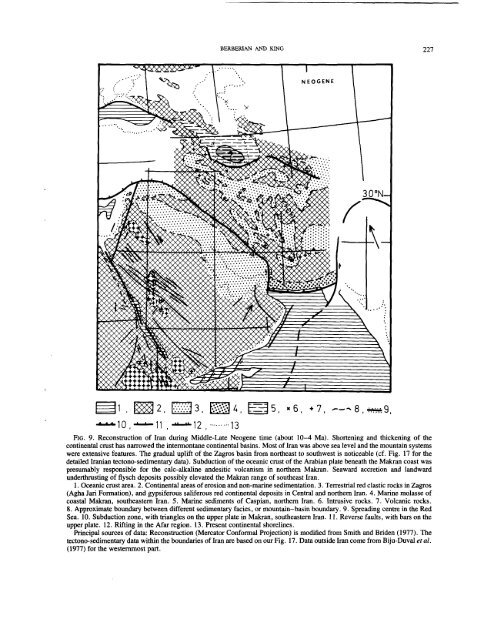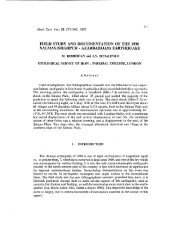PDF COPY - Manuel berberian
PDF COPY - Manuel berberian
PDF COPY - Manuel berberian
Create successful ePaper yourself
Turn your PDF publications into a flip-book with our unique Google optimized e-Paper software.
BERBERIAN AND KING 227<br />
NEOGENE<br />
/ I<br />
-’-’-’-10, --’--’-- 11 , ""-"12," ........ 13<br />
FIG. 9. Reconstruction of Iran during Middle-Late Neogene time (about 10-4 Ma). Shortening and thickening of the<br />
continental crust has narrowed the intermontane continental basins. Most of Iran was above sea level and the mountain systems<br />
were extensive features. The gradual uplift of the Zagros basin from northeast to southwest is noticeable (cf. Fig. 17 for the<br />
detailed Iranian tectono-sedimentary data). Subduction of the oceanic crust of the Arabian plate beneath the Makran coast was<br />
presumably responsible for the calc-alkaline andesitic volcanism in northern Makran. Seaward accretion and landward<br />
underthrusting of flysch deposits possibly elevated the Makran range of southeast Iran.<br />
1. Oceanic crust area. 2. Continental areas of erosion and non-marine sedimentation. 3. Terrestrial red clastic rocks in Zagros<br />
(Agha Jari Formation), and gypsiferous saliferous red continental deposits in Central and northern Iran. 4. Marine molasse<br />
coastal Makran, southeastern Iran. 5. Marine sediments of Caspian, northern Iran. 6. Intrusive rocks. 7. Volcanic rocks.<br />
8. Approximate boundary between different sedimentary facies, or mountain-basin boundary. 9. Spreading centre in the Red<br />
Sea. 10. Subduction zone, with triangles on the upper plate in Makran, southeastern Iran. 11. Reverse faults, with bars on the<br />
upper plate. 12. Rifting in the Afar region. 13. Present continental shorelines.<br />
Principal sources of data: Reconstruction (Mercator Conformal Projection) is modified from Smith and Briden (1977).<br />
tectono-sedimentary data within the boundaries of Iran are based on our Fig. 17. Data outside Iran come from Biju-Duval et al.<br />
(1977) for the westernmost part.







